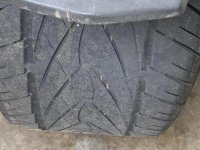I don't know what Forums you might've been looking at to have seen a recommendation for running 28 psi in a non-OEM auto tire on the rear of a Spyder, cos AFAIK,
THIS Forum's been touting the '
more appropriate lower pressure for lighter loads' thing pretty much ever since about 2010, and certainly since 2013ish?!? :dontknow: We may not have been quite so comfortable saying 16-18psi all round will suit "the majority" of riders back then, but that was really only because back then we hadn't yet seen how minor the differences that result from the range of variables that can go into optimum pressure calculations are across the board - the relatively minor differences in variables in things like the possible loads that our Spyders can carry & the limited range of tires in sizes that actually fit under them have proven over time to make very little difference in the end result, and these days, it's fairly clear that 16-18 psi covers just about all the possible permutations until people/loads/tire sizes/ambient temps etc start getting waaayyy out towards the extremities of the bell-curve! :thumbup:
And when it comes to your tire choices, either we seem to get a whole different lot of Kumhos out here than you lot get over there, or our road surfaces are markedly different, cos (when running at the right pressures

)
our Oz Spec Kumhos seem to work pretty well & don't have anywhere near the hydroplane issues some have commented on in your neck of the woods?! (Or possibly it's just another tire pressure issue?? Who knows? :dontknow: ) So bearing that in mind, I reckon it doesn't really matter too much which tire you choose, cos you'll likely be pleasantly surprised at the improved traction PLUS better ride & handling you'll get from
any of those tires (when run at the right pressures, of course!

) There again, we don't often see Vredestein tires here Down Under, and our General's aren't easy to get in Spyder compatible sizes; but from what I've seen here about how they each perform over there, out of those you mention, the Vreds would probably be the top choice, the General Altimax next, with the Kumho's third, followed by just about any good quality Grand Touring tire that'll fit. Of course, if you really want to go High Performance, there are other tires that will make your pockets substantially lighter and
might add a
little improvement in one or more performance aspects; but for my 2 bob's worth, unless you're going into the obscenely expensive specialist performance tires (that are really capable of performing well beyond the Spyder's capabilities anway) there's just not all that much difference!

When the tire meets the tarmac, just about
ANYTHING that's approved to run on a car in your country or mine is most likely going to be quids ahead of the OE Spec Kendas; most of them will outperform the Kendas in pretty much all aspects of tire performance; altho more recently, the stock Kendas have apparently been
less prone to the quality issues that plagued them from the beginning and made them the single most limiting & disappointing thing about our Spyders... but only time will tell if that change sticks! In the meantime, if you can find a tire that sounds like it'll do what you want it to, takes your fancy, & actually fits under the fenders even if it's not exactly the same nominal size, then I'd say go for it!

hyea:
Enjoy! :cheers:
) At this point, I'll pick a new rear and work on having it inflated properly. I am leaning to the Vreds just because my fronts have been great. I am wondering if I would notice any handling difference from a Vred at 205/60 to a General or Kuhmo 215/60 provided they are properly inflated this time.

